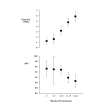Block-dependent sedation during epidural anaesthesia is associated with delayed brainstem conduction
- PMID: 15220178
- PMCID: PMC1361808
- DOI: 10.1093/bja/aeh192
Block-dependent sedation during epidural anaesthesia is associated with delayed brainstem conduction
Abstract
Background: Neuraxial anaesthesia produces a sedative and anaesthetic-sparing effect. Recent evidence suggests that spinal cord anaesthesia modifies reticulo-thalamo-cortical arousal by decreasing afferent sensory transmission. We hypothesized that epidural anaesthesia produces sensory deafferentation-dependent sedation that is associated with impairment of brainstem transmission. We used brainstem auditory evoked potentials (BAEP) to evaluate reticular function in 11 volunteers.
Methods: Epidural anaesthesia was induced with 2-chloroprocaine 2%. Haemodynamic and respiratory responses, sensory block level, sedation depth and BAEP were assessed throughout induction and resolution of epidural anaesthesia. Sedation was evaluated using verbal rating score (VRS), observer's assessment alertness/sedation (OAA/S) score, and bispectral index score (BIS). Prediction probability (PK) was used to associate sensory block with sedation, as well as BIS with other sedation measures. Spearman's rank order correlation was used to associate block level and sedation with the absolute and interpeak BAEP latencies.
Results: Sensory block level significantly predicted VRS (PK=0.747), OAA/S score (PK=0.748) and BIS. BIS predicted VRS and OAA/S score (PK=0.728). The latency of wave III of BAEP significantly correlated with sedation level (rho=0.335, P<0.01) and sensory block (rho=0.394, P<0.01). The other BAEP parameters did not change during epidural anaesthesia. Haemodynamic and respiratory responses remained stable throughout the study.
Conclusions: Sedation during epidural anaesthesia depends on sensory block level and is associated with detectable block-dependent alterations in the brainstem auditory evoked responses. Sensory deafferentation may reduce CNS alertness through mechanisms related to brainstem neural activity.
Figures


Similar articles
-
Changes in the rapidly extracted auditory evoked potentials index and the bispectral index during sedation induced by propofol or midazolam under epidural block.Br J Anaesth. 2002 Aug;89(2):260-4. doi: 10.1093/bja/aef187. Br J Anaesth. 2002. PMID: 12378664
-
Subarachnoid anaesthesia in caesarean delivery: effects on alertness.Minerva Anestesiol. 2003 Nov;69(11):809-19, 819-24. Minerva Anestesiol. 2003. PMID: 14735021 Clinical Trial. English, Italian.
-
Assessment of recovery in patients undergoing intravenous conscious sedation using bispectral analysis.J Oral Maxillofac Surg. 2001 Jun;59(6):603-11; discussion 611-2. doi: 10.1053/joms.2001.23366. J Oral Maxillofac Surg. 2001. PMID: 11381378 Clinical Trial.
-
Evaluation of endovenous sedation using BIS monitoring in dentistry. A systematic review.Med Oral Patol Oral Cir Bucal. 2020 Jul 1;25(4):e439-e448. doi: 10.4317/medoral.22884. Med Oral Patol Oral Cir Bucal. 2020. PMID: 32520922 Free PMC article.
-
Cardiovascular and pulmonary effects of epidural anaesthesia.Anaesth Intensive Care. 2000 Dec;28(6):620-35. doi: 10.1177/0310057X0002800603. Anaesth Intensive Care. 2000. PMID: 11153287 Review.
Cited by
-
Using EEG to monitor anesthesia drug effects during surgery.J Clin Monit Comput. 2006 Dec;20(6):445-72. doi: 10.1007/s10877-006-9044-x. J Clin Monit Comput. 2006. PMID: 17103250 Review.
-
Electroencephalographic assessment of infant spinal anesthesia: A pilot prospective observational study.Paediatr Anaesth. 2021 Nov;31(11):1179-1186. doi: 10.1111/pan.14294. Epub 2021 Sep 24. Paediatr Anaesth. 2021. PMID: 34510633 Free PMC article.
-
Caudal analgesia reduces the sevoflurane requirement for LMA removal in anesthetized children.Korean J Anesthesiol. 2010 Jun;58(6):527-31. doi: 10.4097/kjae.2010.58.6.527. Epub 2010 Jun 23. Korean J Anesthesiol. 2010. PMID: 20589176 Free PMC article.
-
Neostigmine decreases bupivacaine use by patient-controlled epidural analgesia during labor: a randomized controlled study.Anesth Analg. 2009 Aug;109(2):524-31. doi: 10.1213/ane.0b013e31819518e4. Epub 2009 Apr 17. Anesth Analg. 2009. PMID: 19377050 Free PMC article. Clinical Trial.
-
Effects of intrathecal bupivacaine on the NR2B/CaMKIIα/CREB signaling pathway in the rat lumbar spinal cord.Mol Med Rep. 2018 Mar;17(3):4508-4514. doi: 10.3892/mmr.2018.8448. Epub 2018 Jan 17. Mol Med Rep. 2018. PMID: 29344649 Free PMC article.
References
-
- Tverskoy M, Shifrin V, Finger J, Fleyshman G, Kissin I. Effect of epidural bupivacaine block on midazolam hypnotic requirements. Reg Anesth. 1996;21:209–13. - PubMed
-
- Ben-David B, Vaida S, Gaitini L. The influence of high spinal anesthesia on sensitivity to midazolam sedation. Anesth Analg. 1995;81:525–8. - PubMed
-
- Tverskoy M, Shagal M, Finger J, Kissin I. Subarachnoid bupivacaine blockade decreases midazolam and thiopental hypnotic requirements. J Clin Anesth. 1994;6:487–90. - PubMed
-
- Inagaki Y, Mashimo T, Kuzukawa A, Tsuda Y, Yoshiya I. Epidural lidocaine delays arousal from isoflurane anesthesia. Anesth Analg. 1994;79:368–72. - PubMed
-
- Hodgson PS, Liu SS, Gras TW. Does epidural anesthesia have general anesthetic effects? A prospective, randomized, double-blind, placebo-controlled trial. Anesthesiology. 1999;91:1687–92. - PubMed
Publication types
MeSH terms
Grants and funding
LinkOut - more resources
Full Text Sources
Miscellaneous

